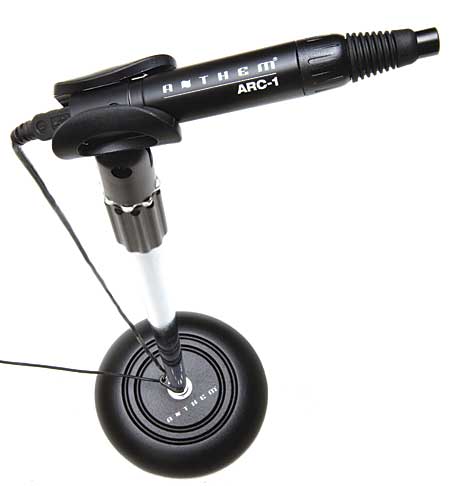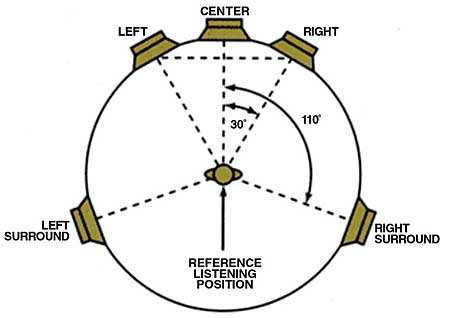Configuring Your Speakers
Getting all the pieces for that new system into your room is just the first step to home theater bliss. You’ll need to set up the A/V receiver’s inputs, position the speakers, and configure the AVR’s speaker adjustments for balanced sound before you get to movie time. I’ll frequently refer to your AVR, but the steps will be identical for a separates system with a surround processor and power amp.

Configuring the system isn’t as complicated as many owner’s manuals make it seem. Most AVRs guide you through the operation through their onscreen setup menus by breaking the process down into organized, manageable steps. The process is basically the same for all systems: connect and set up the sources, connect and position the speakers, and set the A/V receiver’s speaker configuration controls. A growing number of A/V receivers also add automated setup and sophisticated room equalization to their list of features.
Source Setup
In some A/V receivers, source setup is intuitive. You connect your DVD player to the DVD input, your TV to the TV input, your satellite box to the SAT input, and so on. However, some receivers may not label their inputs as DVD, SAT, TV, AUX, etc., but rather AUX 1, AUX 2, Digital 1, Digital 2, Component 1, Component 2, HDMI, etc. These receivers will ask you to designate which source you have connected to each of these inputs. For example, you might connect your satellite receiver to Component 1 and your Blu-ray player to HDMI. In most cases, the receiver will then let you rename these inputs so that its front-panel window will read Blu-ray and SAT instead of HDMI and Component 1.
For analog video sources (composite, S-video, and component), you’ll not only find video jacks but also a choice of audio inputs, either analog or digital (optical or coaxial). Make sure that you assign the audio and video to the same input selection in the menu, or you may find that when you select the input, you get audio but no video—or vice versa.
If you want to listen to the new high-resolution lossless audio soundtracks that are found on most Blu-ray Discs—Dolby TrueHD, DTS-HD Master Audio, and multichannel PCM—you must use either multichannel analog connections from the player to the receiver (six separate analog leads) or an HDMI link. The old optical and coaxial digital inputs can only carry two-channel (stereo) PCM digital or multichannel as old school (lossy compressed) Dolby Digital and DTS.
Some Blu-ray players offer multichannel analog audio outputs. But HDMI is the way to go if you want the best high-resolution audio and video, not to mention the easiest connection. HDMI can carry both audio and video from the source to the receiver on a single lead. You simply connect an HDMI cable between each source and the receiver, assign the sources to the connected input when you set up the receiver (as in the above example, Blu-ray to HDMI), and you’re good to go. But with older sources, such as an old cable box that lacks an HDMI output, you’ll have to use separate audio and video connections. Some audiophiles argue that a two-channel CD coaxial (not optical) digital link sounds better than HDMI, but that’s a controversial discussion for another time.
Speaker Setup
I’ll assume that you’ve properly positioned your speakers. (See Darryl Wilkinson’s “Speakers: Where Do I Put Them?” feature on page 30.) That means the left and right front speakers flank the screen symmetrically and are far enough apart to produce good separation but close enough together that there’s a center image and no hole in the middle when you listen to two-channel stereo. The surrounds will be positioned behind the listener. The recommended surround location (for a 5.1-channel setup) is generally 110 degrees from the center speaker (to the left and right and just slightly behind the main listening area). However, in some rooms, you may need to position them further to the rear.
You should locate the subwoofer in the position that produces the deepest, tightest, most well-defined bass possible. If you haven’t determined this location yet—and most newbies have not—the process can involve a lot of trial and error. For your first try, choose a promising location; a common recommendation is between the center and right front speaker. If this doesn’t work as well as you’d like, move the sub around the room (with appropriate readjustment of the level, distance, and other setup controls in your AVR each time) until you find the best spot. Selecting the optimum location for the subwoofer is an art. Books have been written about it (well, many thousands of words at least). Many of you will be perfectly happy with the first location you try. The location is usually influenced by practical room considerations, not to mention the demands of your in-house interior decorator! Others will fuss for weeks for that last ounce of bass magic. That’s up to you.
Speaker Configuration
Once the speakers are in position, you’ll need to set up the system to account for a number of factors, including the distance of each speaker from the listener, how much bass you want each speaker to carry, how you want to redirect the bass, and what each channel’s playback level is.

For this discussion, we assume that you’ll perform these adjustments in your AVR. Many disc players, both DVD and Blu-ray, also offer setup for these parameters. Most often, these only affect a player’s analog audio outputs. If you must use a multichannel analog connection from player to receiver, configuring the player may be the only way to dial in the settings for that source. Most receivers’ multichannel analog inputs offer little more than level adjustments. But for all other inputs, the receiver’s setup is by far the best way to go. In fact, most of you are unlikely to use the multichannel analog inputs at all.








































